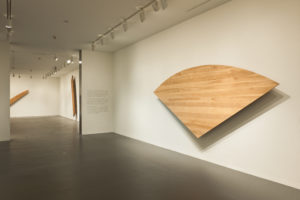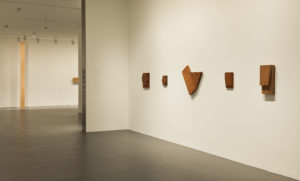Ellsworth Kelly Wood Sculpture
Museum of Fine Arts
September 18 – March 4, 2012
Boston 2011

Diagonal with Curve XV
EK 717
Diagonal with Curve XVI
EK 721
Curve XXI
EK 613

Curve XXXVI
EK 711
Untitled
EK 710
Curve in Relief V
EK 718
Concorde Relief II
EK 585
Diagonal with Curve XV
EK 717

Curve XXXVIII
EK 713
Palm Relief
EK 159
Form in Relief
EK 157
Untitled
EK 584
Concorde Relief I
EK 158
Concorde Relief II
EK 585
Curve XLIII
EK 720
Concorde Relief IV
EK 677

Curve XLII
EK 719
Diagonal with Curve XV
EK 717
Diagonal with Curve XVI
EK 721

Curve XXXVIII
EK 713
Curve XXXVII
EK 712
Palm Relief
EK 159
Form in Relief
EK 157
Untitled
EK 584
Concorde Relief I
EK 158
Concorde Relief II
EK 585

Diagonal with Curve XVI
EK 721
Curve XXI
EK 613
Curve XLIII
EK 720
“I call them my totems.” With these unassuming words, Ellsworth Kelly defines as talismanic the thirty wood sculptures he created over the span of four decades, between 1958 and 1996. In so identifying this relatively small body of work (less than twelve percent of his sculpture oeuvre) Kelly implies that wood as a material has foundational significance to him.
… There’s an ineffable quality inherent to wood that appeals to Kelly. Whereas iron, steel, and aluminum are “hard and cold,” he explains, wood is “softer.”
… Wood, of course, is not simply wood; the medium is not generic. Kelly has worked with birchwood, elm, mahogany, maple, oak (both red and white), padouk, redwood, sapele wood, sycamore, teak, walnut, wenge, and zebrawood. He relishes the sensual range in color and subtle traceries highlighted in certain grain patterns of the various woods he considers for sculptures. Pointing out the expressive waves and ripples in the grain of the caramel-toned blistered sapele wood of Curve XLIII (1984), Kelly commented with delight, “This always reminds me of Chinese landscape painting.”
… “From the very beginning, Ellsworth Kelly’s work has been “of nature.” The natural world is a touchstone for him. Nature is implicit in the soaring verticals and myriad curves of his totems. The wood sculptures embody a deeply personal expression of Kelly’s commitment to abstract art, to nature, and to harmony (as in the French “concorde,” one of the artist’s favorite words) in matters large and small. A family of works linked by the medium of wood, these thirty sculptures speak to Kelly’s lifetime of acute visual observation, intellectual curiosity, daring originality, and unflagging reinvention. Above all, Ellsworth Kelly knows that both life and art are fundamentally spiritual endeavors. His totems bear witness to that conviction.”
– excerpts from “Ellsworth Kelly’s Totem” by Brenda Richardson, independent curator and author of the catalogue of the exhibition
Few artists of the last century have matched Ellsworth Kelly’s groundbreaking achievement in creating art so resolutely abstract and yet so rooted in observation of the manmade and natural world. His works radically blur the boundaries between painting and sculpture, and his exploration of form, color, figure, ground, line and shape is ceaseless. Although the artist’s long career has been marked by many acclaimed exhibitions and publications, his work still surprises—none of it more so than the thirty beautiful wood sculptures made between 1958 and 1996. Ellsworth Kelly Wood Sculpture, which accompanies the exhibition of the same name, is the first publication to focus on these sculptures, beguiling in form and materials.
– introduction by Malcolm Rogers, Director, Museum of Fine Arts
Ellsworth Kelly Wood Sculpture at the Museum of Fine Arst, Boston, an exhibition of nineteen wood sculptures from private and public collections opens October 7 and will be on view through January 22.


